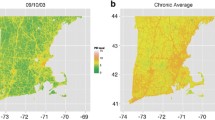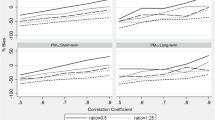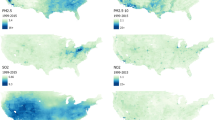Abstract
Determining whether there is a causal link between chronic exposure to PM2.5 (atmospheric particulate matter with a diameter of 2.5 µm or less) and mortality is a fundamental challenge in determining appropriate air quality standards for PM2.5. While numerous epidemiological studies have found a statistical association between PM2.5 and mortality, unmeasured confounding in this relationship remains a concern. Several recent studies have examined the possibility of unmeasured confounding of the long-term association between PM2.5 exposure and mortality by decomposing PM2.5 into two orthogonal components — a “global” component that measures the national trend in pollution, and a “local” component that measures the local trend in pollution after controlling for the national trend. Generally, these “PM decomposition” studies find that while PM2.5 and mortality are trending downward over time at the national level, areas with steeper declines in PM2.5 do not have correspondingly steep declines in mortality. This finding is consistent with the long-term relationship between PM2.5 and mortality being confounded by some other, unmeasured, long-term trends. However, alternative explanations for these findings have been proposed under which there is still a causal link between PM2.5 and mortality. This study conducts simulation-based tests of four of these proposed alternative explanations — the omission of spatial variation in PM2.5 and mortality, confounding at the local level, measurement error, and an association between PM2.5 and mortality at a different time scale than those tested in the PM decomposition studies. We find that none of these alternative explanations can reproduce the results in the PM decomposition studies while simultaneously allowing for a causal link between PM2.5 and mortality.


















Similar content being viewed by others
Data and code availability
The simulated datasets and the code to analyze them are available from the corresponding author on reasonable request.
Notes
This would have been a futile task because along with such demographic features, one would also need to have the actual survival outcomes of those populations, in which data are not publicly available. Our simulations instead assume no demographic heterogeneity from location to location other than the simulated effect on mortality risk of the assumed C-R relationship, as described further below.
Since the equation defining the C-R function is on a log-linear scale, we employ log hazard ratios to characterize PM2.5 mortality risk as inputs to our simulation.
Each of the 10 simulated datasets is equivalent to the single dataset that would be available to an epidemiological study based on observed data. Thus, we do not consider multiple testing bias in our simulations (see Bender and Lange [32]).
When the hazard ratio is quite small, as is the case in the PM2.5 literature, the logarithm of the hazard ratio is approximately equal to the hazard ratio minus 1, or the percent increase (i.e., 0.01 if the relative risk is 1.01).
Measurement errors with such a standard deviation imply that the true PM2.5 exposures may differ from the estimated levels with a 95% range of about 4 µg/m3. This is very large given that the average PM2.5 level for 2000–2006 across all the data used by Greven et al. [8] is only about 12.9 µg/m3 (we did truncate measurement errors when they fell below 0, but the main point is that standard deviations above 2 µg/m3 are very large, and perhaps unrealistically large).
In the simulations which involve no systemic bias and an untruncated error term, bifurcation occurs at large standard errors, and the local coefficient becomes totally attenuated and not significantly greater than 0. These simulations, however, allow for implausible magnitudes of error with outcomes that include negative PM2.5 values and month-to-month changes (measured in terms of the annual average of daily PM2.5 values) that would require the most recent month to have average PM2.5 concentrations to be greater than 40 µg/m3 compared to the PM2.5 concentrations from 13 months prior. Thus, the results from these simulations are not presented in this paper.
References
Dockery, D. W., Pope, C. A., Xu, X., Spengler, J. D., Ware, J. H., Fay, M. E., Ferris, B. G., Jr., & Speizer, F. E. (1993). An association between air pollution and mortality in six US cities. New England Journal of Medicine., 329(24), 1753–1759.
Eftim, S., Samet, J., Janes, H., McDermott, A., & Dominici, F. (2008). Fine particulate matter and mortality: A comparison of the six cities and American Cancer Society cohorts with a Medicare cohort. Epidemiology, 19(2), 209–216.
Laden, F., Schwartz, J., Speizer, F., & Dockery, D. (2006). Reduction in fine particulate air pollution and mortality: Extended follow-up of the Harvard six cities study. American Journal of Respiratory and Critical Care Medicine, 173(6), 667–672.
Lepeule, J., Laden, F., Dockery, D., & Schwartz, J. (2012). Chronic exposure to fine particles and mortality: An extended follow-up of the Harvard six cities study from 1974 to 2009. Environmental Health Perspectives, 120(7), 965–970.
Pope, C. A. III, Thun, M. J., Namboodiri, M. M., Dockery, D. W., Evans, J. S., Speizer, F. E., & Heath, C. W. (1995). Particulate air pollution as a predictor of mortality in a prospective study of U.S. adults. American Journal of Respiratory and Critical Care Medicine, 151(3), 669–674.
Pope, C. A., Ezzati, M., & Dockery, D. W. (2009). Fine-particulate air pollution and life expectancy in the United States. New England Journal of Medicine, 360, 376–386.
Qian, DI., Wang, Y., Zanobetti, A., Wang, Y., Koutrakis, P., Choirat, C., Dominici, F., & Schwartz, J. D. (2017). Air pollution and mortality in the Medicare population. New England Journal of Medicine, 376, 2513–2522.
Greven, S., Dominici, F., & Zeger, S. L. (2011). An approach to the estimation of chronic air pollution effects using spatio‐temporal information. Journal of the American Statistical Association. J Am Stat Assoc. 106(494), 396‐406.
Janes, H., Dominici, F., & Zeger, S. L. (2007). Partitioning evidence of association between air pollution and mortality (author’s response). Epidemiology, 18(4), 427–428.
Janes, H., Dominici, F., & Zeger, S. L. (2007). Trends in air pollution and mortality: An approach to the assessment of unmeasured confounding. Epidemiology, 18(4), 416–423.
Moolgavkar, S. (1994). Air pollution and mortality. New England Journal of Medicine, 330(17), 1237–1238.
Vedal, S. (1997). Ambient particles and health: Lines that divide. Journal of the Air & Waste Management Association, 47(5), 551–581.
Gamble, J. (1998). PM2.5 and mortality in long-term prospective cohort studies: Cause-effect or statistical associations? Environmental Health Perspectives, 106(9), 535–549.
Wang, B., Eum, K., Kazemiparkouhi, F., Cheng, Li., Manijourides, J., Pavlu, V., & Suh, H. (2020). The impact of long-term PM2.5 exposure on specific causes of death: exposure-response curves and effect modification among 53 million U.S. Medicare beneficiaries. Environmental Health, 19(20).
Schwartz, J., & Dockery, D. (1992). Particulate air pollution and daily mortality in Steubenville. Ohio. American Journal of Epidemiology, 135(1), 12–19.
Spix, C., Heinrich, J., Dockery, D., Schwartz, J., Völksch, G., Schwinkowski, K., Cöllen, C., & Wichmann, H. (1993). Air pollution and daily mortality in Erfurt, East Germany, 1980–1989. Environmental Health Perspectives, 101(6), 518–526.
Kelsall, J., Samet, J., Zeger, S. L., & Xu, J. (1997). Air pollution and mortality in Philadelphia, 1974–1988. American Journal of Epidemiology, 146(9), 750–762.
Lumley, T., & Sheppard, L. (2000). Assessing seasonal confounding and model selection bias in air pollution epidemiology using positive and negative control analyses. Environmetrics, 11(6), 705–717.
Moolgavkar, S. H. (2005). A review and critique of the EPA’s rationale for a fine particle standard. Regulatory Toxicology and Pharmacology, 42(1), 123–144.
Eum, K., Suh, H., Pun, V. C., & Manjourides, J. (2018). Impact of long-term temporal trends in fine particulate matter (PM2.5) on association of annual PM2.5 exposure and mortality: an analysis of over 20 million Medicare beneficiaries. Environmental Epidemiology, 2(2):e009.
Pun, V. C., Kazemiparkouhi, F., Manijourides, J., & Suh, H. (2017). Long-term PM2.5 exposure and respiratory, cancer, and cardiovascular mortality in older US adults. American Journal of Epidemiology, 186(8), 961–969.
Dominici, F., Zeger, S. L., Janes, H., & Greven, S. (2012). Reply to: Additional information to EPA for these two studies. Memo dated November 28, 2012.
Pope, C. A., & Burnett, R. T. (2007). Confounding in air pollution epidemiology: The broader context. Epidemiology, 18(4), 424–426.
Cox, L. A. (2017). Socioeconomic and air pollution correlates of adult asthma, heart attack, and stroke risks in the United States, 2010–2013. Environmental Research, 155, 92–107.
Cox, L. A. (2021). Socioeconomic correlates of air pollution and heart disease. In Quantitative risk analysis of air pollution health effects (pp. 357–372). International Series in Operations Research and Management Science, Springer.
Moolgavkar, S. H., Chang, E. T., Watson, H. N., & Lau, E. C. (2018). An assessment of the Cox proportional hazards regression model for epidemiologic studies. Risk Analysis, 38(4), 777–794.
Butland, B. K., Armstrong, B., Atkinson, R. W., Wilkinson, P., Heal, M. R., Doherty, R. M., & Vieno, M. (2013). Measurement error in time-series analysis: A simulation study comparing modelled and monitored data. BMC Medical Research Methodology, 13(136), 1–12.
Cox, L. A. (2018). Effects of exposure estimation errors on estimated exposure-response relations for PM2.5. Environmental Research, 164, 636–646.
Cox, L. A. (2021). How do exposure estimation errors affect estimated exposure-response relations? In Quantitative Risk Analysis of Air Pollution Health Effects (pp. 449–474). International Series in Operations Research and Management Science, Springer.
Dionisio, K. L., Chang, H. H., & Baxter, L. K. (2016). A simulation study to quantify the impacts of exposure measurement error on air pollution health risk estimates in copollutant time-series models. Environmental Health, 15(114), 1–10.
Rhomberg, L. R., Chandalia, J. K., Long, C. M., & Goodman, J. E. (2011). Measurement error in environmental epidemiology and the shape of exposure-response curves. Critical Reviews in Toxicology, 41(8), 651–671.
Bender, R., & Lange, S. (2001). Adjusting for multiple testing – When and how? Journal of Clinical Epidemiology, 54(4), 343–349.
Zeger, S. L., Thomas, D., Dominici, F., Samet, J. M., Schwartz, J., Dockery, D., & Cohen, A. (2000). Exposure measurement error in time-series studies of air pollution: Concepts and consequences. Environmental Health Perspectives, 108(5), 419–426.
U.S. E.P.A. (2004). Advisory Council on Clean Air Compliance Analysis response to agency request on cessation lag, EPA-COUNCIL-LTR-05–001, December.
Bell, M., Dominici, F., Ebisu, K., Zeger, S., & Samet, J. (2007). Spatial and temporal variation in PM2.5 chemical composition in the United States for health effects studies. Environmental Health Perspectives, 115(7), 989–995.
Funding
This work was funded by the Texas Commission on Environmental Quality (TCEQ).
Author information
Authors and Affiliations
Contributions
Anne E. Smith developed the simulation approach. Wonjun Chang, Garrett Glasgow, and Bharat Ramkrishnan contributed to the development of the simulation code. Wonjun Chang, Garrett Glasgow, Bharat Ramkrishnan, and Anne E. Smith contributed to the writing of the manuscript. All authors read and approved the final manuscript.
Corresponding author
Ethics declarations
Ethics approval and consent to participate
Not applicable.
Consent for publication
Not applicable.
Competing interests
The authors declare no competing interests.
Additional information
Publisher's Note
Springer Nature remains neutral with regard to jurisdictional claims in published maps and institutional affiliations.
Rights and permissions
About this article
Cite this article
Chang, W., Glasgow, G., Ramkrishnan, B. et al. A Simulation-Based Assessment of Alternative Explanations for Apparent Confounding in “PM Decomposition” Studies. Environ Model Assess 27, 665–692 (2022). https://doi.org/10.1007/s10666-022-09829-2
Received:
Accepted:
Published:
Issue Date:
DOI: https://doi.org/10.1007/s10666-022-09829-2




